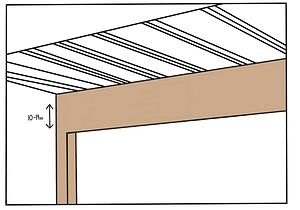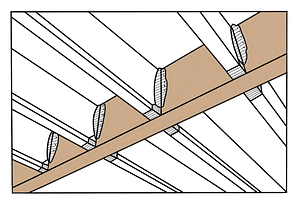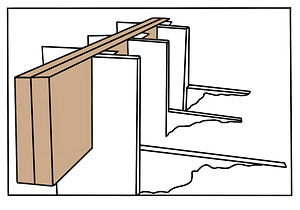Need to remove a wall?
We do THE MATH.
We transform your space into something exceptional.
We are structural engineers that provide drawings, beam selection, and approval stamp required to remove load-bearing walls.
Permit Packages starting at $2200.
Keep your home safe.
One common mistake in wall removal is not properly identifying the type of wall being removed. Load-bearing walls are essential for supporting the weight of a home, and removing them can cause serious structural damage.
It’s important to have a professional assess the type of wall being removed before proceeding with the renovation.
Our structural engineering firm Kingswood Engineers Ltd. will provide drawings and beam selection and will assist in obtaining permit approval.
Our Process
1
Site visit by a professional engineer
Our on-site engineer assesses the property to understand the structural requirements of the wall removal.
2
Preliminary engineering design
We create a structural model and discuss the preliminary results. Once you confirm the plan, we finalize the design.
3
Architectural drawings and permit submission
Our team will produce precise architectural drawings and manage the permit submission process.
Frequently asked questions
The cost of engineering design for a wall removal depends on several key factors such as length of opening, what is located above the proposed beam, access in the basement, etc. The fees start from:
- Site Visits from $300+hst
- Engineering Design for removal of load-bearing walls from $900+hst
- Architectural Drawings for building permit from $1100+hst
For most renovation projects that require structural alternations, a building permit is required. We can provide a complete package to clients, or only work on the engineering design component, depending on your needs.
The age of a home has a significant impact on the engineering required when removing a wall. A visual inspection of the framing is always the first step
- We come on site to discuss the details of the project and take the required measurements
- When removing a load bearing wall, it is also critical to identify how the new loads will be transferred to the foundations.
- We also identify the sections of the home that the current wall is supporting
- Finally, we assess the framing in the attic to see if the wall is carrying roof loads. Snow can have a significant impact on the size of beam and foundations required
- We would then input all the load data for your property into our software and calculate the required beam size and assess the need for additional posts/foundations in the basement to transfer the new loads down through the basement.
- If foundation work is required, we would engineer the type and size on foundations as well
- This information is then summarized in a stamped engineering letter.
The most important step to take is to hire a contractor with experience. For structural work on your home, you want piece of mind. Some of the main steps in the process are summarized below.
- Before removing the existing partition wall, add temporary supports on either side to ensure a safe working environment.
- Correctly size the beam that will replace the current wall. A structural engineer will be able to model the loads and let you know which size of beam you will need.
- Work with your engineer to decide if a flush beam is possible. The result is a cleaner finish but will require specialized beam selection and potentially more HVAC/electrical rework.
- Consider what the new beam will rest on. The loads from above must always be transferred to the foundations. A new footing might be needed if there is nothing for the beam to rest on.
- It is very important to redirect any HVAC ducts that are currently in the wall. Remember, HVAC is all about air flow; you need to keep the same amount of air going into a room and going out of a room.
There are three main steps to the process
- Engineering Design – The typical turnaround time for engineering design once the measure-up has been completed is 5-12 business days.
- Permit Approval – If you are applying for a building permit, the response time from the building department is mandated to be 10 business days. Given the extremely high level of renovation work in Ontario, this ranges widely from 3 weeks to 8 weeks.
- Construction – Depending on the experience of the contractors, removal of a single wall is a 4-7 day job. The typical turnaround time for a contractor is usually 1-3 weeks.
Every home is different. It can be difficult to know without removing some drywall. A few go-to ways to know if a wall is load-bearing are listed below.
- The easiest way is to check your original plans. If you do not have them, your local building department might. You can call the building department and request records for your property.
- Start in the Basement. Check if the wall is resting on top of a beam or wall in the basement. This usually means the wall you want to remove is load-bearing.
- Check in your attic. If you have trusses that rest on the exterior wall, that is a good sign your wall is not load-bearing.
- Open up your ceiling near the wall and check if the ceiling joists rest on that wall. If the ceiling framing is perpendicular to your wall, most likely you have a load-bearing wall.
- Check for headers/lintels above doorways in the wall. If there is a 2×10″ or 2×12″ header in the framing above an opening in the wall, then it is most likely a load-bearing wall.
- Ask an Engineer! Most often, with some good photos, a structural engineer will be able to tell you if the wall is load-bearing.
There are several options available when removing a load bearing wall. For typical wall removals, the most common beam options are engineered wood products such as LVLs (Layered Veneer Laminate) and Steel I-Beams.
Overlapping Setup – Beam is placed directly underneath the existing ceiling joists. This is the simplest and most common approach but does take 10-14 inches of headroom.

In-line or Flush Setup – The ceiling joists are cut back, and the beam is inserted in between the existing joists. The joists are then attached to the beam via steel hangers and nails or screws. This option allows for an extra 6-8 inches of headroom.

Blind Beam Setup – If there is only an attic space above the proposed wall to be removed, there is an option to install the new beam entirely within the attic and use steel bracket to hold the ceiling joists. This is the cleanest option and allows for all the work to be complete prior to the removal of the existing wall below. It also results in a flush beam design.


